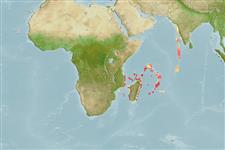分類 / Names
俗名 | 同種異名 | Catalog of Fishes(屬, 種) | ITIS | CoL | WoRMS | Cloffa
Teleostei >
Eupercaria/misc (Various families in series Eupercaria)
鱸形目 (Various families in series Eupercaria) >
Labridae (Wrasses)
隆頭魚科 (Wrasses) > Cheilininae
Etymology: Pteragogus: Greek, pteron = wing, fin + Greek, ago = to drive (Ref. 45335); variabilis: Named for the great variation in color, not only as shown in color photographs of different fish, but in the same individual..
Environment: milieu / climate zone / depth range / distribution range
生態學
海洋 礁區魚類; 深度上下限 0 - 71 m (Ref. 93522).
Indian Ocean: Mauritius, Seychelles (Aldabra Atoll), and Cargados Carajos (St. Brandon’s Shoals).
大小 / 重量 / 年齡
Maturity: Lm ? range ? - ? cm
Max length : 5.8 cm SL 雄魚/尚未辨別雌雄; (Ref. 93522)
簡短描述
型態特徵 | 形態測量圖
背棘 (總數): 11; 背的軟條 (總數): 9; 臀棘 3-9; 臀鰭軟條: 9; 脊椎骨: 24. This species is distinguished by the following characters: D XI,9; A III,9; pectoral rays 13-14 (usually 13), the rays flattened at tips but not branched; complete lateral line, angling sharply downward below soft portion of anal fin to straight peduncular part; pored scales 24 (plus 2 on base of caudal fin, the last greatly enlarged); body moderately deep, 2.7-3.05 depth in SL; head length 2.55-2.6 in SL; dorsal profile of head straight; straight part of posterior margin of preopercle serrate, serrae varying from 13 on 3.4-cm paratype to 25 on 5.8-cm paratype; absence of long filaments extending from tips of dorsal spines; rounded caudal fin and moderately long 3.1-3.15 in SL; first soft ray of pelvic fins moderately long, reaching between origin of anal fin and origin of soft portion of anal fin, 3.2-4.1 in SL. Colour in life very variable, with the ground color being brown, sometimes suffused with orange, red, or yellow; or greenish gray, orange-yellow, or red; all sharing the following features: opercle of darker color, often more red, orange, or yellow than rest of head, and containing an oblique elliptical ocellus; four white spots along anterior lateral line, the fourth anteriorly on caudal peduncle, with irregular white spots and flecks extending dorsally from first three spots into dorsal fin, and ventrally from all four spots; a broad white posterior border on preopercle, with an adjacent white triangular band on opercle; white dots extending ventrally and posteroventrally from orbit; median and pelvic fins colored much like adjacent body, but with more small white blotches and dots; dorsal fin with a blackish spot on first membrane and usually a smaller spot on second membrane; about posterior three-fourths of soft portion of fin transparent, except basally (the transparent zone may be crossed by brown lines); caudal fin with a series of white or transparent spots along dorsal margin and smaller spots along ventral margin; color in alcohol pale brownish yellow, an oblique elliptical ocellus about twice pupil diameter in length on opercle (often damaged, sometimes effaced), a short dark brown dash on side of snout before middle of eye, dark dots sometimes faintly visible on nape, fins translucent pale yellowish with the dorsal having a blackish spot on first membrane and usually a second smaller spot on second membrane, a small dark brown spot at rear base of dorsal fin; some specimens, including holotype, may be entirely pale yellowish with no dark markings (Ref. 93522).
Life cycle and mating behavior
成熟度 | 繁殖 | 產卵場 | 卵 | 孕卵數 | 仔魚
Oviparous, distinct pairing during breeding (Ref. 205).
Randall, J.E., 2013. Seven new species of labrid fishes (Coris, Iniistius, Macropharyngodon, Novaculops, and Pteragogus) from the Western Indian Ocean. J. Ocean Sci. Found. 7:1-43. (Ref. 93522)
人類使用
漁業:
更多資訊
俗名同種異名新陳代謝捕食者生態毒物學繁殖成熟度產卵場產卵群集孕卵數卵卵發育
年龄/大小成長長度-重量長度-長度長度-頻率形態測量圖型態特徵仔魚稚魚動力學入添量豐度BRUVS
參考文獻養殖養殖資訊品種遺傳學Electrophoreses遺傳率疾病加工NutrientsMass conversion
合作者照片Stamps, Coins Misc.聲音神經毒速度泳型鰓區Otoliths腦重體重比眼睛色素
工具
特別的報告
下載 XML
網路資源
Estimates based on models
Preferred temperature (Ref.
123201): 26.3 - 27.3, mean 26.5 °C (based on 10 cells).
Phylogenetic diversity index (Ref.
82804): PD
50 = 0.5010 [Uniqueness, from 0.5 = low to 2.0 = high].
Bayesian length-weight: a=0.02188 (0.00887 - 0.05395), b=2.97 (2.76 - 3.18), in cm total length, based on LWR estimates for this (Sub)family-body shape (Ref.
93245).
營養階層 (Ref.
69278): 3.3 ±0.4 se; based on size and trophs of closest relatives
回復力 (Ref.
120179): 高度, 族群倍增時間少於 15個月 (Preliminary K or Fecundity.).
Fishing Vulnerability (Ref.
59153): Low vulnerability (10 of 100).
